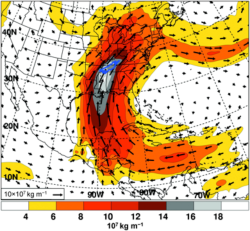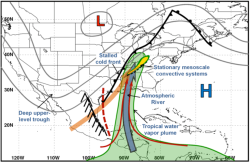
Figure 1.
|

Figure 2.
Click images for more details
|
|
Contact: Benjamin Moore
|
HMT Publication Notice
NOAA HMT has been exploring a regional implementation of HMT in the Southeastern U.S. following successful efforts in the Western U.S. After the major flood in Tennessee in May 2010 it was decided to explore the physical processes that contributed hydrometeorologically to that disastrous flood. As it turned out, the atmospheric conditions that caused this event included a well-defined atmospheric river (AR). While HMT-West has spearheaded research into ARs in the West, which has led to development and implementation of numerous key tools and data sets, this paper represents the first full documentation of an AR impacting a region in the Eastern U.S. The analysis also led to the development of a diagnostic method whereby the vertically integrated water vapor transport (IVT), which was identified by HMT-West as a key variable identifying AR conditions, is also integrated over time. This highlights the persistence of AR conditions (Fig. 1) that was a key ingredient in the Tennessee flood case documented in this paper. It is important to note that HMT helped sponsor grants through CSTAR focused on QPF, including one led by Dr. Lance Bosart and Dr. Daniel Keyser at SUNY Albany. In addition to that project advancing understanding of the role of "Predecessor Rain Events" (PREs) in extreme rainfall important to the Southeast US, it also helped train a graduate student, Ben Moore, who is the lead on this study. Also, the analysis was contributed to significantly by Faye Barthold, who is located at NCEP/HPC under support from NOAA HMT.
 Read the Abstract
Read the Abstract